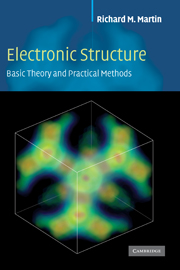Book contents
- Frontmatter
- Contents
- Preface
- Acknowledgments
- Notation
- Part I Overview and background topics
- Part II Density functional theory
- Part III Important preliminaries on atoms
- Part IV Determination of electronic structure: the three basic methods
- Part V Predicting properties of matter from electronic structure – recent developments
- 18 Quantum molecular dynamics (QMD)
- 19 Response functions: phonons, magnons, …
- 20 Excitation spectra and optical properties
- 21 Wannier functions
- 22 Polarization, localization, and Berry's phases
- 23 Locality and linear scaling O(N) methods
- 24 Where to find more
- Appendix A Functional equations
- Appendix B LSDA and GGA functionals
- Appendix C Adiabatic approximation
- Appendix D Response functions and Green's functions
- Appendix E Dielectric functions and optical properties
- Appendix F Coulomb interactions in extended systems
- Appendix G Stress from electronic structure
- Appendix H Energy and stress densities
- Appendix I Alternative force expressions
- Appendix J Scattering and phase shifts
- Appendix K Useful relations and formulas
- Appendix L Numerical methods
- Appendix M Iterative methods in electronic structure
- Appendix N Code for empirical pseudopotential and tight-binding
- Appendix O Units and conversion factors
- References
- Index
21 - Wannier functions
from Part V - Predicting properties of matter from electronic structure – recent developments
Published online by Cambridge University Press: 05 June 2012
- Frontmatter
- Contents
- Preface
- Acknowledgments
- Notation
- Part I Overview and background topics
- Part II Density functional theory
- Part III Important preliminaries on atoms
- Part IV Determination of electronic structure: the three basic methods
- Part V Predicting properties of matter from electronic structure – recent developments
- 18 Quantum molecular dynamics (QMD)
- 19 Response functions: phonons, magnons, …
- 20 Excitation spectra and optical properties
- 21 Wannier functions
- 22 Polarization, localization, and Berry's phases
- 23 Locality and linear scaling O(N) methods
- 24 Where to find more
- Appendix A Functional equations
- Appendix B LSDA and GGA functionals
- Appendix C Adiabatic approximation
- Appendix D Response functions and Green's functions
- Appendix E Dielectric functions and optical properties
- Appendix F Coulomb interactions in extended systems
- Appendix G Stress from electronic structure
- Appendix H Energy and stress densities
- Appendix I Alternative force expressions
- Appendix J Scattering and phase shifts
- Appendix K Useful relations and formulas
- Appendix L Numerical methods
- Appendix M Iterative methods in electronic structure
- Appendix N Code for empirical pseudopotential and tight-binding
- Appendix O Units and conversion factors
- References
- Index
Summary
Summary
Wannier functions are enjoying a revival as important, practical tools for electronic structure. They have a long history of providing useful localized functions for formal proofs; however, they are often not regarded as useful because of their inherent non-uniqueness, that is, a dependence upon the choice of a “gauge.” This has changed with the realization that Wannier functions can be used effectively to calculate important physical quantities in a gauge-invariant manner. In addition, the particular construction of “maximally localized Wannier functions” provides elegant connections to the Berry's phase formulation of polarization. The subjects of this and the following two chapters are closely related: the expressions given here are useful in understanding localization and polarization, the subject of Ch. 22, and the discussion there brings out the physical meaning of the quantities derived in this chapter. The emergence of “order-N” methods (Ch. 23) has given impetus to the development of useful localized functions closely related to Wannier functions.
Definition and properties
Wannier functions [338, 759, 763] are orthonormal localized functions that span the same space as the eigenstates of a band or a group of bands. Extensive reviews of their properties have been given by Wannier [338], Blount [759], and Nenciu [339]. Here we consider properties relevant to understanding the electronic properties of materials and to presentday practical calculations.
The eigenstates of electrons in a crystal are extended throughout the crystal with each state having the same magnitude in each unit cell.
- Type
- Chapter
- Information
- Electronic StructureBasic Theory and Practical Methods, pp. 418 - 433Publisher: Cambridge University PressPrint publication year: 2004



